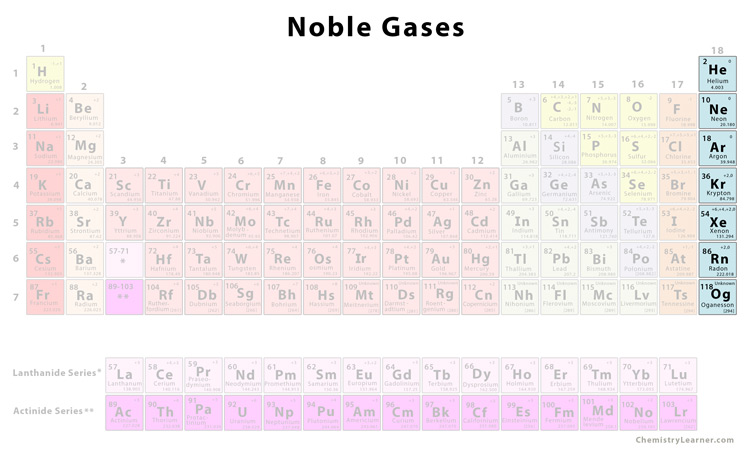Noble Gases
Definition: What are noble gases?
Noble gases belong to a special category of elements in the periodic table that are inert, non-metal, and non-reactive. The special feature of these elements is that their outermost orbital is complete and do not have any free electrons to participate in chemical reactions. Hence, they exist as monoatomic molecules. Because of their unreactive nature, they can be used in applications where chemical reactions are undesired [1].
Where are the noble gases located on the periodic table?
The noble gases are located toward the right of the periodic tablein group number VIIIa (new IUPAC) or 18 (CAS) [1].
List of Noble Gases [1] |
|
| Element | Symbol |
| Helium | He |
| Neon | Ne |
| Argon | Ar |
| Krypton | Kr |
| Xenon | Xe |
| Radon | Rn |
Common Properties and Characteristics of Noble gases
The properties and characteristics of noble gases can be traced back to their atomic structure. The arrangement of electrons in noble gases is such that their valence shell isfull and complete. As a result, there are no electrons to participate in chemical bonding, thereby, rendering them stable and inert. This explains why they do not have any chemical reactivity [2 – 4]. A noticeable fact about noble gases is that they are generally present in Earth’s atmosphere with argon being the most abundant.
Physical Properties of Noble Gases[3]
- Noble gases have very weak interatomic forces and have very low melting and boiling points.
- The atomic mass, boiling point, and atomic radii of noble gases increase as we go down the periodic table.
- Noble gases have large ionization energies due to their inertness.
- First ionization energies decrease as the atomic radii increase, because further the valence electron is from the nucleus the easier it is to remove that electron [3].
Table 2: Physical Properties of Noble gases [2].
| Property | Helium | Neon | Argon | Krypton | Xenon | Radon |
| Atomic number | 2 | 10 | 18 | 36 | 54 | 86 |
| Density at STP (grams per liter) | 0.17847 | 0.899 | 1.784 | 3.75 | 5.881 | 9.73 |
| Melting Temperature (°C) | -272.2 | -248.59 | -189.3 | -157.36 | -111.7 | -71 |
| Boiling Temperature (°C) | -268.93 | -246.08 | -185.8 | -153.22 | -108 | -61.7 |
Noble Gas Configuration
Because they have complete valence orbital, the atomic configuration of noble gas can be used to designate the configuration of other elements of the periodic table. For example, neon has an atomic number of 10 and its atomic configuration is written as 1s22s22p6or [Ne]. Chlorine has an atomic number of 17 and its configuration is denoted as 1s22s22p63s23p2, but, can be written in a much shorter form which is [Ne]3s23p5. Likewise, calcium with an atomic number of 20 can be designated as [Ar] 4s2 [5].
Applications of Noble Gases
Noble gases have a wide variety of applications ranging from incandescent light bulbs to excimerlasers. Typically, a charge is sent through a tube containing a particular noble gas which, then, excites the gas giving distinctive radiation and color. This is the principle behind gas-discharge tubes and lamps [6].
- Helium being the lightest is used for filling party balloons [7]. Its atomic weight is twice that of hydrogen gas.
- Neon is famous for its reddish-orange glow that is used in neon signs. It can be mixed with helium to make helium-neon laser, which is commonly used in spectroscopy [7].
- Argon is also used in incandescent light bulbs and in excimer lasers [7].
- Krypton is used to produce white light for photography [7].
- Xenon is used in high luminosity light bulbs that are used in lighthouses and in short-arc lamps [7]. It is also used in anesthetics because of its ability to dissolve in lipids [1].
- Radon is the heaviest of the noble gases and, being radioactive, is used in radiotherapy [1].
- References
- Definition of Noble Gases – Wikipedia.org
- Properties of Noble Gases – Britannica.com
- Properties of Noble Gases – Chem.libretexts.org
- Properties of Noble Gases – Courses.lumenlearning.com
- Noble Gas Configuration – Chem.libretexts.org
- Applications of Noble Gases – Courses.lumenlearning.com
- Applications of Noble Gases – Open.edu
